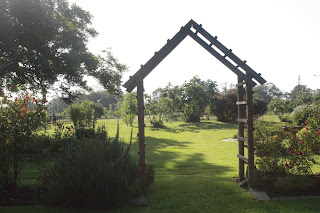Yesterday, I enjoyed a peaceful few hours tidying up the North Garden. I removed countless spent blooms, pulled a few weeds, and organized my small potting shed. Today, I thought I would spend the greater part of the day in the garden. I was so excited; I had grand, ambitious plans for my day's work. But after an hour or so of dealing with the elements, I changed my mind! I simply was not in the mood for heat, humidity, and bugs.
It was fine. I had another sort of gardening work to do! I have been enjoying a short, online gardening course even though I started late and have been behind ever since. Perhaps you've heard of "My Garden School", founded by Elspeth Briscoe and Duncan Heather. Horticultural courses are offered by many different experts, covering topics as diverse as organic gardening, garden design, natural beekeeping, and pond and lake construction, to name a few. From what I've seen, most or all of the courses are four weeks long and every week there is a video and accompanying notes that can be downloaded and printed out, assignments, and one on one dialogue with the teachers.
In a previous blog, I mentioned wanting to learn more about gardening history. I thought I could teach myself and so I could, but what an immense topic! Finally, I thought I should look online for some sort of course outline to give me an idea of how to go about it. I was happily surprised to stumble upon Toby Musgrave's "Garden History Matters" website (http://www.gardenhistorymatters.com/) and astonished to find that he was teaching an online class about garden history. What a grand coincidence and so far, it's been a grand experience, too. Professor Musgrave, who has authored several gardening books, provides an interesting, succinct trip through the ages, examining and explaining the history of gardening, how it developed, different gardening styles, and more. I am afraid that I've been a rather difficult student, always asking questions, but he's answered them swiftly and thoroughly. I've learned a great deal. As I mentioned, it's a vast subject, but Professor Musgrave has broken it down very neatly.
There are other benefits to My Garden School. For one thing, once an online class has been published, it can be accessed at the student's convenience; the video can be watched again and again. Students have the opportunity to learn from some of the best in the field; these experts also contribute to a blog. Another plus is the staff; I've found everyone to be kind and helpful. Here I was, in the U.S., wanting to sign up for a class that's managed in the UK and had already started. But they made it easy; their correspondence was prompt and very pleasant. I love it!
So if you feel like treating yourself to a convenient gardening class from an expert, you might want to check out My Garden School: http://www.my-garden-school.com/. If you are interested in garden history, Toby Musgrave's class is not to be missed.
Tomorrow, I suppose I will have to go outside and do some actual hands-on gardening. We have some nice blooms, but there's a lot of work waiting, too!




.jpg)









